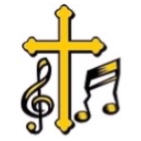Introduction to Gospel Chords
Four chords are commonly used when playing Traditional Gospel Music. These chords do not exhaust the list of chords used. However, they do provide a foundation upon which a beginning Traditional Gospel musician may build a musical piece. The four chords are: major sixth, dominant seventh, minor sixth, and the diminished seventh.
The chord tones of the four chords listed above may be rearranged to give a musical piece a desired sound. There are four possible arrangements of these chords. Three of these arrangements are similar to the root position, first inversion and second inversion of triads. A fourth position (not a real musical term but used her for discussion) places a note below the root note.
|
Root Position
|
Middle C = 1 = R
|
E = 3
|
G = 5
|
A = 6
|
|
1st Inversion
|
E = 3
|
G = 5
|
A = 6
|
C Octave = 8
|
|
2nd Inversion
|
G = 5
|
A = 6
|
C Octave = 8
|
E = 10
|
|
other (4th)
|
A = 6
|
C Octave = 8
|
E = 10
|
G = 12
|
|
Root Position
|
Middle C = 1 = R
|
E = 3
|
G = 5
|
Bb = b7
|
|
1st Inversion
|
E = 3
|
G = 5
|
Bb = b7
|
C Octave = 8
|
|
2nd Inversion
|
G = 5
|
Bb = b7
|
C Octave = 8
|
E = 10
|
|
other (4th)
|
Bb = b7
|
C Octave = 8
|
E = 10
|
G = 12
|
|
Root Position
|
Middle C = 1 = R
|
Eb = b3
|
G = 5
|
A = 6
|
|
1st Inversion
|
Eb = b3
|
G = 5
|
A = 6
|
C Octave = 8
|
|
2nd Inversion
|
G = 5
|
A = 6
|
C Octave = 8
|
Eb = b10
|
|
other (4th)
|
A = 6
|
C Octave = 8
|
Eb = b10
|
G = 12
|
|
Root Position
|
Middle C = 1 = R
|
Eb = b3
|
Gb = b5
|
Bbb = bb7
|
|
1st Inversion
|
Eb = b3
|
Gb = b5
|
Bbb = bb7
|
C Octave = 8
|
|
2nd Inversion
|
Gb = b5
|
Bbb = bb7
|
C Octave = 8
|
Eb = b10
|
|
other (4th)
|
Bbb = bb7
|
C Octave = 8
|
Eb = b10
|
Gb = b12
|
Another way to play these chords is to omit one of the chord tones. The chord tone omitted is usually the fifth degree or the root note. The following are alternate arrangements of the four chords listed above:
|
- Play the major sixth chord without the fifth degree.
- Play the dominant seventh chord without the root note.
- Play the minor sixth chord without the fifth degree.
|
Adding Bass Notes
Bass notes may be added by playing the root note of the chord played in the treble clef. The root note is played in the base clef as a single tone. It may also be played as a part of a two-tone chord of root notes spanning one octave.
Bass notes are also notated using symbols. Bass notes are notated by a slash (/) followed by a letter naming the bass note to be played. (Example: /C) This notation immediately follows the notation for chords. The following are examples of chord notations that include the bass note.
|
Chord Notations that include Bass Notes
|
|
C/R/C
|
C major triad in the root position with C played in the bass.
|
|
Fm/2/F
|
F minor triad in the second position with F played in the bass.
|
|
G+/3/G
|
G augmented triad in the third position with G played in the bass.
|
|
E-5/R/E
|
E lowered fifth triad in the root position with E played in the bass.
|
|
A7/4/A
|
A dominant seventh chord played with the seventh degree under the root note and A played in the bass.
|
|
Ddim7/R/D
|
D diminished seventh chord in the root position with D played in the bass.
|
The minor sixth chord is unique in that it has a wonderful sound when played with the fourth degree in the bass clef. This does not follow the general rule for adding bass notes to a musical piece. However, the sound is so distinct that it warrants mentioning.
The following is a list of minor sixth chords played with the sixth degree under the root note. The fourth degree is played in the bass. The fourth degree is the degree of the major scale from which the minor sixth chord was formed.
|
Cm6/4/F
|
Fm6/4/Bb
|
Gm6/4/C
|
|
Em6/4/Bb
|
Am6/4/F
|
Dm6/4/G
|
|

